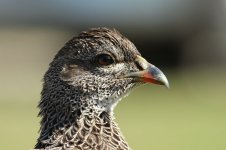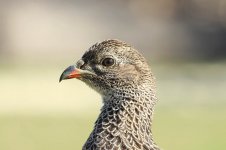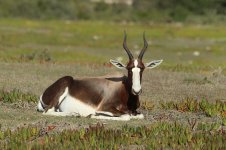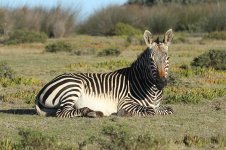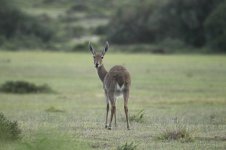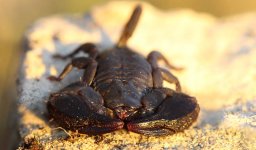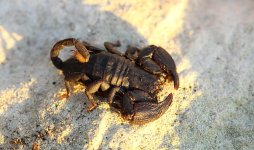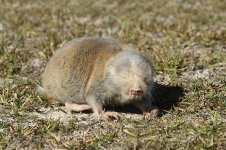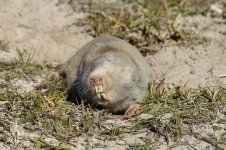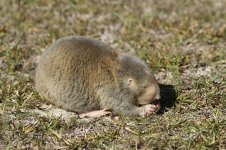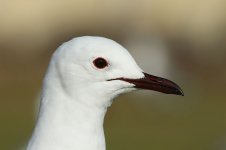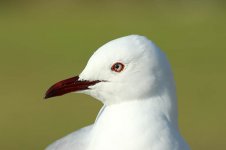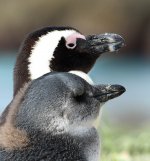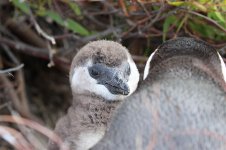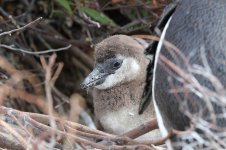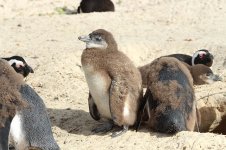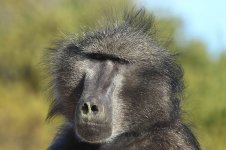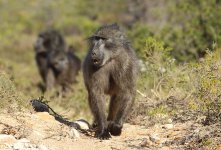
-
Welcome to BirdForum, the internet's largest birding community with thousands of members from all over the world. The forums are dedicated to wild birds, birding, binoculars and equipment and all that goes with it.
Please register for an account to take part in the discussions in the forum, post your pictures in the gallery and more.
You are using an out of date browser. It may not display this or other websites correctly.
You should upgrade or use an alternative browser.
You should upgrade or use an alternative browser.
South Africa 2017, On the Path of the Nocturnals. (1 Viewer)
- Thread starter Jos Stratford
- Start date
More options
Who Replied?

24 June.
A bit nippy at dawn, but still a good selection around the campsite at dawn, not least several Southern Tchagras and a pair of Spotted Eagle Owls. Also Fiscal Flycatchers, Southern Boubous, Bokmakierie et al, but I didn't however find a Knysna Woodpecker, a localised resident that favours the dense trees around the camping area.
As for the rest of the day, fairly relaxing with another visit to the coast, this time notching up at least 10 Southern Right Whales, plus a couple of Cape Sugarbirds and four Cape Grasslands, then a visit to the nearby Potburg section of De Hoop. Fifteen Blue Cranes and a gang of 25 White-necked Ravens on farmland just before, then Bushbuck and Greater Honeyguide around the parking area as I arrived. The main reason for visiting Potburg however was already hanging low overhead – impressive Cape Vultures swinging in towards the cliffs above, locality of the only colony in the Western Cape. At least fifteen drifting about while I was there, plus, on rather smaller scale, my only butterflies seen in Cape Province on this trip – a couple of Brown-veined Whites very active.
My main target of this day however was to try again for Cape Clawless Otter. Well before dusk, I positioned myself some kilometres north of the camping area and perched upon a rock pinnacle to scan the waters below – masses and masses of birds to keep me entertained, including three Giant Kingfishers, but most impressive was the mass flights of cormorants for the last couple of hours of the afternoon, all heading into roost in a small wooded inlet – thousands upon thousands of Reed Cormorants streaming past, hundreds of White-breasted Cormorants and African Anhingas too, very nice. My younger travelling companion also found a small Thin-tailed Scorpion on a rock, proudly bringing the rock with scorpion balanced atop for me to see! Probably just as well it wasn't a Thick-tailed Scorpion Then, just a dusk was beginning, finally found a Cape Clawless Otter, a single rather distant individual nosing around in the rocky shallows, clambering up onto boulders. Pretty rubbish views it has to be admitted.
Then, just a dusk was beginning, finally found a Cape Clawless Otter, a single rather distant individual nosing around in the rocky shallows, clambering up onto boulders. Pretty rubbish views it has to be admitted.
A nicer surprise was an African Wildcat darting across the track on route back to camp and, nicer still, was what was awaiting at the small boathouse near the campsite – at exactly the same spot that I had checked the night before, five Cape Clawless Otters coming straight across the vlei! As the sun set, so they swam right under the rock I was sat on, spiralling around in crannies at the cliff edge trying to catch fish. An excellent end to the day, six Water Thick-knees also at the boathouse, plus a big swift flock overhead – Alpine Swifts, Black Swifts and Little Swifts. Back at the chalet, a Fiery-necked Nightjar sitting on the lawn!
A bit nippy at dawn, but still a good selection around the campsite at dawn, not least several Southern Tchagras and a pair of Spotted Eagle Owls. Also Fiscal Flycatchers, Southern Boubous, Bokmakierie et al, but I didn't however find a Knysna Woodpecker, a localised resident that favours the dense trees around the camping area.
As for the rest of the day, fairly relaxing with another visit to the coast, this time notching up at least 10 Southern Right Whales, plus a couple of Cape Sugarbirds and four Cape Grasslands, then a visit to the nearby Potburg section of De Hoop. Fifteen Blue Cranes and a gang of 25 White-necked Ravens on farmland just before, then Bushbuck and Greater Honeyguide around the parking area as I arrived. The main reason for visiting Potburg however was already hanging low overhead – impressive Cape Vultures swinging in towards the cliffs above, locality of the only colony in the Western Cape. At least fifteen drifting about while I was there, plus, on rather smaller scale, my only butterflies seen in Cape Province on this trip – a couple of Brown-veined Whites very active.
My main target of this day however was to try again for Cape Clawless Otter. Well before dusk, I positioned myself some kilometres north of the camping area and perched upon a rock pinnacle to scan the waters below – masses and masses of birds to keep me entertained, including three Giant Kingfishers, but most impressive was the mass flights of cormorants for the last couple of hours of the afternoon, all heading into roost in a small wooded inlet – thousands upon thousands of Reed Cormorants streaming past, hundreds of White-breasted Cormorants and African Anhingas too, very nice. My younger travelling companion also found a small Thin-tailed Scorpion on a rock, proudly bringing the rock with scorpion balanced atop for me to see! Probably just as well it wasn't a Thick-tailed Scorpion
A nicer surprise was an African Wildcat darting across the track on route back to camp and, nicer still, was what was awaiting at the small boathouse near the campsite – at exactly the same spot that I had checked the night before, five Cape Clawless Otters coming straight across the vlei! As the sun set, so they swam right under the rock I was sat on, spiralling around in crannies at the cliff edge trying to catch fish. An excellent end to the day, six Water Thick-knees also at the boathouse, plus a big swift flock overhead – Alpine Swifts, Black Swifts and Little Swifts. Back at the chalet, a Fiery-necked Nightjar sitting on the lawn!

kittykat23uk
Well-known member
For a rabbit?
Did consider it, but opted for other stuff.
Lol well there is more to see than the rabbit. But yes I went for the rabbit..

25 June. De Hoope, De Mond & Rooi Els.
A quick look round before departure, again concentrating on the campsite area – Southern Tchagras and Spotted Eagle Owls again. But one notable addition too – a very quiet tapping attracting me to the final remaining star of the area, a Knysna Woodpecker. Very difficult to actually see, it spent the whole time edging up trunks and branches right in the depths of the thickets, rarely visible at all and only a few times in full view. Still a nice bird to end the De Hoop experience and so it was we departed, seven Mountain Zebra and 16 Grey Rhebok as we went.
A fairly rapid drive through the Overburg farmland was productive nevertheless with five Denham's Bustards and 45 Blue Crane the highlights, with several Jackal Buzzards and Black-shouldered Kites amongst the rest, plus Agulhaus Long-billed Larks and Large-billed Larks, quite a few Capped Wheatears and mixed flocks of African Pied Starlings and European Starlings, occasional Red-winged Starlings too.
Partly on the off-chance of Damara Tern, also made a stop at the De Mond, a compact coastal reserve consisting of a small estuary opening out to grand golden beaches. No Damara Terns present this day, and moderately poor in birds overall, about best of the bunch being seven Black Oystercatchers, 12 White-fronted Plovers and a scatter of unseasonal Palearctic migrants, Terek Sandpiper at the head of the list, six Curlew Sandpipers and two Grey Plovers nearby. However, what I was not ready for was a major bonus with the finding of a Cape Dune Mole Rat foraging on a lawn in the bright sunshine, a creature that generally ventures above ground very rarely. As it hunched facing away from me, I initially thought it was a pet rabbit (!), but what a splendid animal - almost blind, its squinty little eyes combine with buck teeth protruding at obscure angles to truly produce a glorification of ugliness!
And with that, we then headed towards Cape Town, a pause on the fire-damaged slopes at Rooi Elys producing a bunch of big butch Baboons, plus a male Cape Rockjumper, a male Sentinal Rock Thrush and a Cape Sugarbird. A few more short stops around False Bay added numerous Cape and White-breasted Cormorants, two White-chinned Petrels and, at the roadside, a couple of White-necked Ravens. Cape Fur Seals in the water, an unexpected Bryde's Whale cruising in False Bay.
Arrived in Cape Town as dark fell, base for the next couple of nights.
A quick look round before departure, again concentrating on the campsite area – Southern Tchagras and Spotted Eagle Owls again. But one notable addition too – a very quiet tapping attracting me to the final remaining star of the area, a Knysna Woodpecker. Very difficult to actually see, it spent the whole time edging up trunks and branches right in the depths of the thickets, rarely visible at all and only a few times in full view. Still a nice bird to end the De Hoop experience and so it was we departed, seven Mountain Zebra and 16 Grey Rhebok as we went.
A fairly rapid drive through the Overburg farmland was productive nevertheless with five Denham's Bustards and 45 Blue Crane the highlights, with several Jackal Buzzards and Black-shouldered Kites amongst the rest, plus Agulhaus Long-billed Larks and Large-billed Larks, quite a few Capped Wheatears and mixed flocks of African Pied Starlings and European Starlings, occasional Red-winged Starlings too.
Partly on the off-chance of Damara Tern, also made a stop at the De Mond, a compact coastal reserve consisting of a small estuary opening out to grand golden beaches. No Damara Terns present this day, and moderately poor in birds overall, about best of the bunch being seven Black Oystercatchers, 12 White-fronted Plovers and a scatter of unseasonal Palearctic migrants, Terek Sandpiper at the head of the list, six Curlew Sandpipers and two Grey Plovers nearby. However, what I was not ready for was a major bonus with the finding of a Cape Dune Mole Rat foraging on a lawn in the bright sunshine, a creature that generally ventures above ground very rarely. As it hunched facing away from me, I initially thought it was a pet rabbit (!), but what a splendid animal - almost blind, its squinty little eyes combine with buck teeth protruding at obscure angles to truly produce a glorification of ugliness!
And with that, we then headed towards Cape Town, a pause on the fire-damaged slopes at Rooi Elys producing a bunch of big butch Baboons, plus a male Cape Rockjumper, a male Sentinal Rock Thrush and a Cape Sugarbird. A few more short stops around False Bay added numerous Cape and White-breasted Cormorants, two White-chinned Petrels and, at the roadside, a couple of White-necked Ravens. Cape Fur Seals in the water, an unexpected Bryde's Whale cruising in False Bay.
Arrived in Cape Town as dark fell, base for the next couple of nights.

kittykat23uk
Well-known member
Wow! Cool critter! 
Great report as ever
Love South Africa so we really must try for Ardvark and Ardwolf
Love South Africa so we really must try for Ardvark and Ardwolf
JWN Andrewes
Poor Judge of Pasta.
Wow Jos, that Mole Rat is just fabulous! Rest of the trip not too shabby either, good write up as ever.

What is not apparent from the photographs is the size of the Mole Rat - basically size of a small rabbit, was really impressed with this one.

26 June. Lambert's Bay & Cape Town.
Pretty much an easy-going day - popped up to Lambert's Bay in the morning on the offchance of a few Heaviside's Dolphins (a good locality for them) - failed in this, the only mammals being a whole bunch of Cape Fur Seals flopped across the rocks at the rear of the Cape Gannet colony. As expected though, picked up all four species of cormorant – Cape Cormorants abundant, Crowned Cormorants common, White-breasted Cormorants a few, and Bank Cormorant, just one.
Thereafter, back to Cape Town for touristy afternoon around the Waterfront area. Hartlaub's Gulls and Grey-headed Gulls all over the place, plus one new mammal for the trip - a Grey Squirrel in the Company's Garden, a small city centre park.
Pretty much an easy-going day - popped up to Lambert's Bay in the morning on the offchance of a few Heaviside's Dolphins (a good locality for them) - failed in this, the only mammals being a whole bunch of Cape Fur Seals flopped across the rocks at the rear of the Cape Gannet colony. As expected though, picked up all four species of cormorant – Cape Cormorants abundant, Crowned Cormorants common, White-breasted Cormorants a few, and Bank Cormorant, just one.
Thereafter, back to Cape Town for touristy afternoon around the Waterfront area. Hartlaub's Gulls and Grey-headed Gulls all over the place, plus one new mammal for the trip - a Grey Squirrel in the Company's Garden, a small city centre park.


27 June. Cape Peninsula.
Final day. A tour of the Cape Peninsula, a perfect ending to the trip - four Humpback Whales and one Southern Right Whales off the Cape of Good Hope, 15 Cape Fur Seals in the choppy waters, tens of thousands of Cape Cormorants in vast feeding flocks, smaller numbers of White-breasted Cormorants. Wandering across the fynbos, added a couple of Cape Sugarbirds, four Cape Siskins and a cocktail of sunbirds - two Malachite Sunbirds, four Orange-breasted Sunbirds and two Southern Double-collared Sunbirds.
Then, via a number of Baboons, Bonteboks and Elands stopped in at Simon's Town for a good gawp at the African Penguins - always impressive, even more so these days as the colony contiues to grow. Eyeball to eyeball with penguins, can't complain about that.
And then, as the clock ticked towards the end of my trip, time to squeeze in a visit to the botanical gardens at Kirstenbosch - lost the sun a little as clouds began to hug Table Mountain, but still a very pleasant finale to the trip - oodles of small birds, Sombre Greenbuls, Olive Thrushes, Cape Robin-Chats, African Dusky Flycatchers and Cape White-eyes all common, at least 35 Southern Double-collared Sunbirds also present, plus two Orange-breasted Sunbirds and one Malachite Sunbird, then four Swee Waxbills to round things off, plus my final mammal of the trip - a Small Grey Mongoose sauntering around on a lawn, scattering Hadeda Ibis and Helmeted Guineafowls.
And with that, off to the airport for a mid-afternoon flight out, a Red-winged Blackbird at the terminal my goodbye to South Africa.
Final day. A tour of the Cape Peninsula, a perfect ending to the trip - four Humpback Whales and one Southern Right Whales off the Cape of Good Hope, 15 Cape Fur Seals in the choppy waters, tens of thousands of Cape Cormorants in vast feeding flocks, smaller numbers of White-breasted Cormorants. Wandering across the fynbos, added a couple of Cape Sugarbirds, four Cape Siskins and a cocktail of sunbirds - two Malachite Sunbirds, four Orange-breasted Sunbirds and two Southern Double-collared Sunbirds.
Then, via a number of Baboons, Bonteboks and Elands stopped in at Simon's Town for a good gawp at the African Penguins - always impressive, even more so these days as the colony contiues to grow. Eyeball to eyeball with penguins, can't complain about that.
And then, as the clock ticked towards the end of my trip, time to squeeze in a visit to the botanical gardens at Kirstenbosch - lost the sun a little as clouds began to hug Table Mountain, but still a very pleasant finale to the trip - oodles of small birds, Sombre Greenbuls, Olive Thrushes, Cape Robin-Chats, African Dusky Flycatchers and Cape White-eyes all common, at least 35 Southern Double-collared Sunbirds also present, plus two Orange-breasted Sunbirds and one Malachite Sunbird, then four Swee Waxbills to round things off, plus my final mammal of the trip - a Small Grey Mongoose sauntering around on a lawn, scattering Hadeda Ibis and Helmeted Guineafowls.
And with that, off to the airport for a mid-afternoon flight out, a Red-winged Blackbird at the terminal my goodbye to South Africa.


foresttwitcher
Virtually unknown member

A great read, as always, Jos.
kittykat23uk
Well-known member
Fantastic read Jos! Really enjoyed your report! 

Many thanks.
And finished just in time - flying back to South Africa this evening, different focus this time.
And finished just in time - flying back to South Africa this evening, different focus this time.
Users who are viewing this thread
Total: 2 (members: 0, guests: 2)




